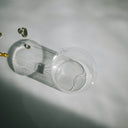When it comes to hairstyles and hairlines, one term that often comes up is "widow's peak." This distinct hairline shape has intrigued many, leading to questions about its characteristics, origins, and how it affects one's appearance. In this article, we'll explore the widow's peak hairline in depth, providing insights and information that can help you understand this unique feature.
Table of content
What is a widow's peak hairline?
A widow's peak hairline is characterized by a V-shaped point at the center of the forehead where the hairline dips downwards. This distinctive shape contrasts with straighter hairlines and is often associated with a dramatic aesthetic. The term "widow's peak" is believed to have originated from the association of the shape with the veils worn by widows in the past, which had a similar pointed appearance.
Widow's peaks can appear in people of all ages and genders, and they can be prominent or subtle, depending on individual genetics. This hairline shape is often more noticeable in certain hairstyles, particularly those that keep the hair pulled back or when the hair is styled in a way that accentuates the forehead.
As your leading source for hair health information over the past 4 years, we never compromise on accuracy. When it comes to your health, you deserve information you can truly rely on - and earning your trust is our top priority.
Here's how Scandinavian Biolabs ensures every piece of content meets the highest standards of accuracy and integrity:
- Credentialed Experts: Our reviewers are actively practicing doctors and medical researchers
- Stringent Reviews: Content undergoes rigorous editing by subject specialists and review by a practicing doctor.
- Evidence-Based: We rely on well-established research from trusted scientific sources like peer-reviewed journals and health authorities.
- Full Transparency: Our editorial standards, writer credentials, reviewer credentials, correction process, and funding are all publicly documented.
- Independent Voice: While we do promote products, we operate in a vacuum to business operations. Our main goal is just an unwavering commitment to providing medically-sound guidance.
You can count on Scandinavian Biolabs to consistently deliver the trustworthy health information you deserve. Read our Editorial Standards.
Is a widow's peak hairline common?
Yes, widow's peak hairlines are relatively common. While they may not be as prevalent as straight hairlines, a significant portion of the population has some form of widow's peak, whether it is pronounced or subtle. Genetics plays a crucial role in determining hairline shapes, so if you have a family history of widow's peaks, you may be more likely to have one yourself.
What causes a widow's peak hairline?
The formation of a widow's peak hairline is primarily due to genetic factors. Hairline shapes are influenced by the distribution of hair follicles and the pattern of hair growth, which are determined by your genes. Additionally, hormonal changes, aging, and hair loss can impact the appearance of your hairline over time, potentially making a widow's peak more pronounced.
How to style hair with a widow's peak?
Styling hair with a widow's peak can be fun and creative. Here are some tips to consider:
- Embrace it: Many individuals with a widow's peak choose to embrace their unique hairline and style their hair in a way that highlights it.
- Side part: A side part can help to soften the appearance of the widow's peak and create balance in your overall look.
- Fringes and bangs: Incorporating fringes or bangs can effectively camouflage a widow's peak while adding texture and style.
- Ponytails and updos: Pulling your hair back into a ponytail or updo can accentuate the widow's peak, making it a focal point of your hairstyle.
Can a widow's peak hairline change over time?
Yes, a widow's peak hairline can change over time due to various factors. As individuals age, their hairlines may recede or change shape due to hormonal shifts, hair loss, or other factors. If you notice significant changes in your hairline, it may be a good idea to consult with a healthcare professional or a dermatologist to understand the underlying causes and potential solutions.
Are there any myths associated with widow's peak hairlines?
Yes, several myths surround widow's peak hairlines. One common myth is that having a widow's peak signifies a person is more prone to balding or hair loss. While genetics do play a role in hair loss, the presence of a widow's peak alone does not determine one's likelihood of experiencing hair thinning or baldness. Another myth is that widow's peaks are exclusively associated with certain personality traits or characteristics, which lacks scientific backing.
Celebrity examples with widow's peak hairlines
Many celebrities are known for their widow's peak hairlines, which have contributed to their iconic looks. Some well-known figures include:
- Ben Affleck: The actor is recognized for his distinctive widow's peak, which adds to his rugged charm.
- Hillary Swank: Swank's widow's peak has been a defining feature throughout her career, complementing her strong facial structure.
- John Travolta: Known for his unique hairstyle choices, Travolta's widow's peak has been part of his signature look.
Conclusion
In conclusion, a widow's peak hairline is a distinctive feature characterized by a V-shaped point at the center of the forehead. While it is relatively common and influenced by genetic factors, it can change over time due to various reasons. Understanding how to style a widow's peak and embracing it as part of your unique appearance can enhance your overall confidence and aesthetic. Whether you choose to highlight or minimize it, your widow's peak is just one of the many beautiful traits that make you who you are.
Tired of Thinning Hair? Try a Clinically Tested Serum.
Looking for a natural way to regrow hair and achieve a thicker, fuller head of hair? Ditch the stinging nettle for hair loss – Bio-Pilixin Serum is a drug-free hair activation serum that delivers clinically tested results.
Here's why Bio-Pilixin is superior:
- Clinically Tested Results: 93% of users saw a reduction in hair loss, and 73% experienced increased hair density.
- Safe and Natural: Unlike harsh chemicals, Bio-Pilixin uses plant growth factors derived from stem cell technology to nourish hair follicles and stimulate growth.
- Fast-Acting: See visible results in as little as 45 days (most typically see results within 150 days).
Stop wasting time on unproven remedies. Bio-Pilixin is the safe & effective serum you've been searching for.
Read more:






